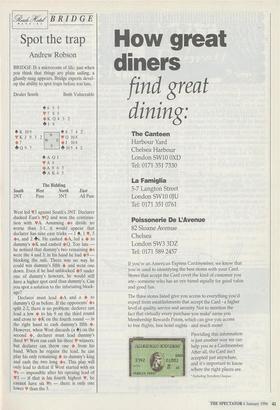M A II F. I it A
BRIDGE
Spot the trap
Andrew Robson
BRIDGE IS a microcosm of life: just when you think that things are plain sailing, a ghastly snag appears. Bridge experts devel- op the ability to spot traps before too late.
Dealer South Both Vulnerable South 2NT The Bidding West North Pass 3NT East All Pass
West led V3 against South's 3NT. Declarer ducked East's VQ and won the continua- tion with VA. Assuming ŌÖ”s divide no worse than 3-1, it would appear that declarer has nine easy tricks ŌĆö 1 4, 1 ŌÖ”, 5 ŌĆó s, and 2 +s. He cashed ŌÖ”A, led a ŌÖ” to dummy's ŌĆóK and cashed ŌÖ”Q. Too late he noticed that dummy's two remaining s were the 4 and 3; in his hand he had ŌÖ”9 blocking the suit. There was no way he could win dummy's fifth ŌÖ” and went one down. Even if he had unblocked ŌÖ”9 under one of dummy's honours, he would still have a higher spot card than dummy's. Can you spot a solution to the infuriating block- age?
Declarer must lead +A and a ŌÖ” to dummy's Q as before. If the opponents' ŌÖ”s split 2-2, there is no problem: declarer can lead a low ŌÖ” to his 9 on the third round and cross to ŌÖ”K on the fourth round ŌĆö in the right hand to cash dummy's fifth ŌÖ”. However, when West discards (a 4) on the second ŌÖ”, declarer must lead dummy's third V! West can cash his three V winners, but declarer can throw one ŌÖ”, from his hand. When he regains the lead, he can play his only remaining ŌÖ” to dummy's king and cash the two long ŌÖ”s. This play will only lead to defeat if West started with six Vs ŌĆö impossible after his opening lead of V3 ŌĆö if that is his fourth highest V, he cannot have six Vs ŌĆö there is only one lower V than the 3.


















































 Previous page
Previous page